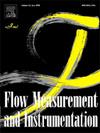脉动热管中的非侵入式质量流量和局部传热系数测量
IF 2.3
3区 工程技术
Q2 ENGINEERING, MECHANICAL
引用次数: 0
摘要
开发了一种单回路脉动加热管(PHP)实验装置,用于非侵入式测量沿 PHP 蒸发器的局部传热系数和质量流。这些测量结果对于验证用于 PHP 设计的建模工具非常有价值。测量质量流时采用了两步差热输入法,并将测量结果与光学和理论结果进行了比较。在 PHP 中测试的条件有:50%、60% 和 70% 的填充率,工作流体为 R134a,内径为 2 毫米,饱和温度为 30 至 40 °C,倾角为 30 至 90°(垂直底部加热模式),蒸发器上的热负荷为 10 至 68 W。结果表明 PHP 的传热性能很高,最小内部热阻值接近 0.008 K/W,在观察到的质量速度值为 60 至 140 kg/m2s 时,局部传热系数大于 10 kW/m2K。结果与文献中的相关数据进行了比较,这些数据能够预测结果,平均误差范围为 20%,表明与对流沸腾机制有许多相似之处。本文章由计算机程序翻译,如有差异,请以英文原文为准。
Non-invasive mass flow and local heat transfer coefficient measurements in pulsating heat pipes
A single loop Pulsating Heating Pipe (PHP) experimental setup was developed for non-invasive measurement of the local heat transfer coefficient and the mass flow along the PHP evaporator. These measurements are valuable to validate modeling tools used in the design of PHP. A two-step differential heat input method was used for measurement of mass flow and the results were compared with the optical and theoretical results. The conditions tested in the PHP were 50, 60 and 70% filling ratio, R134a as working fluid, internal diameter of 2 mm, saturation temperature of between 30 to 40 °C, inclination angles from 30 to 90° (vertical bottom heat mode) and heat loads on the evaporator from 10 up to 68 W. The results indicate a high performance in heat transfer of the PHP, with minimum internal thermal resistance values close to 0.008 K/W as well as local heat transfer coefficients greater than 10 kW/m2K for observed values of mass velocities between 60 and 140 kg/m2s. The results were compared with correlations from the literature and these were able to predict the results with a 20% average error margin, suggesting many similarities with convective boiling mechanisms.
求助全文
通过发布文献求助,成功后即可免费获取论文全文。
去求助
来源期刊

Flow Measurement and Instrumentation
工程技术-工程:机械
CiteScore
4.30
自引率
13.60%
发文量
123
审稿时长
6 months
期刊介绍:
Flow Measurement and Instrumentation is dedicated to disseminating the latest research results on all aspects of flow measurement, in both closed conduits and open channels. The design of flow measurement systems involves a wide variety of multidisciplinary activities including modelling the flow sensor, the fluid flow and the sensor/fluid interactions through the use of computation techniques; the development of advanced transducer systems and their associated signal processing and the laboratory and field assessment of the overall system under ideal and disturbed conditions.
FMI is the essential forum for critical information exchange, and contributions are particularly encouraged in the following areas of interest:
Modelling: the application of mathematical and computational modelling to the interaction of fluid dynamics with flowmeters, including flowmeter behaviour, improved flowmeter design and installation problems. Application of CAD/CAE techniques to flowmeter modelling are eligible.
Design and development: the detailed design of the flowmeter head and/or signal processing aspects of novel flowmeters. Emphasis is given to papers identifying new sensor configurations, multisensor flow measurement systems, non-intrusive flow metering techniques and the application of microelectronic techniques in smart or intelligent systems.
Calibration techniques: including descriptions of new or existing calibration facilities and techniques, calibration data from different flowmeter types, and calibration intercomparison data from different laboratories.
Installation effect data: dealing with the effects of non-ideal flow conditions on flowmeters. Papers combining a theoretical understanding of flowmeter behaviour with experimental work are particularly welcome.
 求助内容:
求助内容: 应助结果提醒方式:
应助结果提醒方式:


